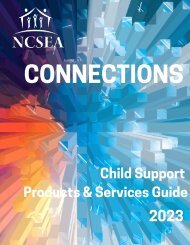January 2024 NCSEA CSQ
Quarterly newsletter containing articles and news of interest for professionals working in the IV-D child support program.
Quarterly newsletter containing articles and news of interest for professionals working in the IV-D child support program.
You also want an ePaper? Increase the reach of your titles
YUMPU automatically turns print PDFs into web optimized ePapers that Google loves.
compliance with the clarified new hire reporting requirements that now<br />
clearly applied to their 1099 independent contractor drivers. The OAG-<br />
CSD’s Employment Services team began meeting with Lyft weekly to work<br />
out logistical issues related to new hire reporting and income withholding<br />
for their drivers. These weekly meetings continued for six months, well past<br />
the law’s effective date.<br />
Some of the issues addressed during the OAG-CSD’s collaboration with<br />
Lyft were:<br />
• Data/file transfer protocols for the state’s employer portal;<br />
• Changes to the portal to create a new identification code for<br />
independent contractors; and<br />
• Instruction on how to properly respond electronically to National<br />
Medical Support Notices that might now be generated to Lyft for<br />
some of their drivers by the state’s automated child support system.<br />
Lyft also made internal processing changes to<br />
reroute IWOs for their drivers from their Payroll<br />
Department to their Accounts Payable<br />
Department since that department pays the<br />
drivers. The OAG-CSD then worked with Lyft’s<br />
Accounts Payable team, which lacked experience processing IWOs, by<br />
providing instruction on properly calculating withholding amounts from<br />
drivers’ periodic earnings, which optionally can be paid to some drivers as<br />
often as daily, including addressing the maximum withholding limits.<br />
Once the law took effect, the impact of both the legislative change and the<br />
OAG-CSD’s collaboration with Lyft was readily apparent. Comparing<br />
numbers for state fiscal year (SFY) 2022 (the year following the effective<br />
date of the legislative change) to the prior year, in SFY 2021:<br />
• IWOs to Lyft increased from 119 per year to almost 10,000 per year<br />
(the monthly average increased from 10 to 828);<br />
• Total yearly collections from Lyft increased from $227,000 to almost<br />
$9.2 million (averaging over $765,000 per month); and<br />
• Total cases paying from Lyft increased from an average of 37 per<br />
month to almost 1,500 per month.















